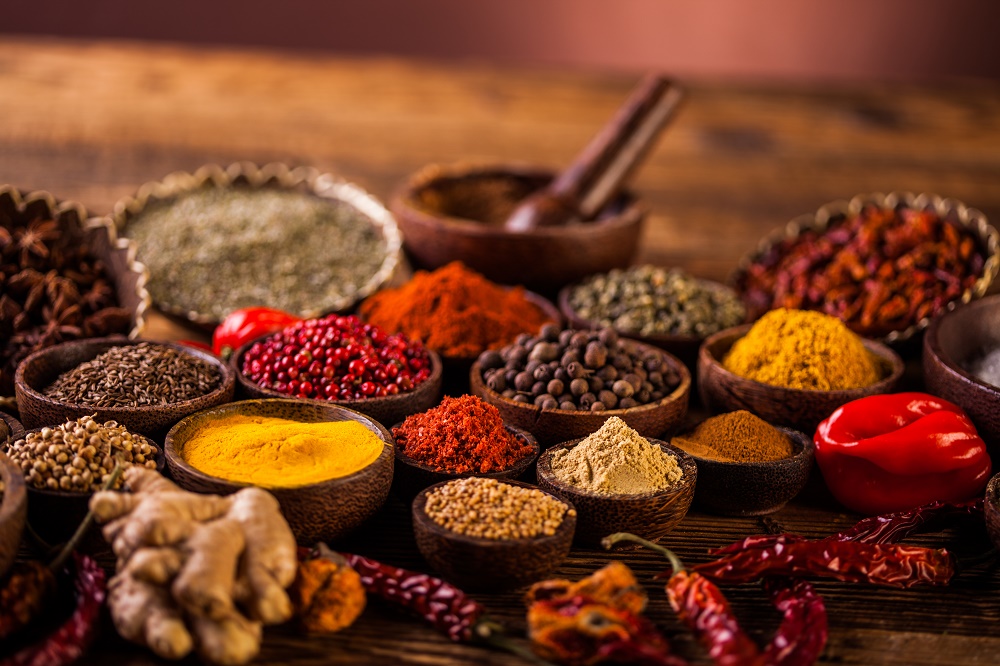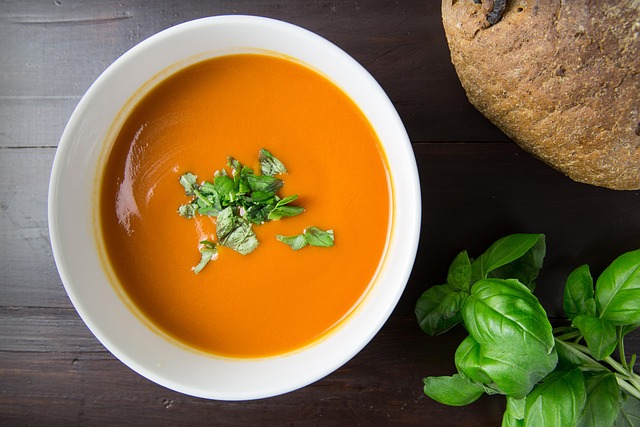
Eating in balance – the wisdom of Ayurvedic nutrition
Pleasure & health in harmony with the seasons
At lunchtime, our Home of Ayurveda somamed smells of soothing spices, fresh herbs and lovingly prepared dishes. Our lunch kitchen is not just a culinary meeting place – it is an expression of our philosophy of holistic, seasonal and individual nutrition tailored to the needs of people and nature.
Fresh seasonal cuisine – tailored to the Ayurvedic Dosha types
Our cuisine is based on the natural rhythms of the seasons – and therefore also on the changing needs of body and mind. In Ayurvedic teachings, the balance of the three doshas – Vata, Pitta and Kapha – plays a central role in health and well-being. Each season has a different effect on these doshas and therefore brings with it its own specific nutritional requirements.

In spring, when kapha dosha dominates, light, stimulating foods help to relieve and detoxify the body. Here, bitter vegetables, fresh herbs and invigorating spices play an important role in restoring energy and lightness.
Summer, on the other hand, brings the pitta dosha to the fore – with heat and intense activity. Cooling, mild dishes with fresh herbs, lots of vegetables and fine aromas ensure that the body remains in balance and does not overheat.


In winter, when the vata dosha is intensified by cold, dryness and wind, we focus on warming, nourishing dishes prepared with soothing spices such as ginger, cinnamon or cumin. Raw food is reduced to relieve digestion and promote inner warmth.
Regional. Organic. Prepared with love
We only put the best on your plate – with maximum care and sustainability. We use:
- Fresh herbs, vegetables and fruit from your own somamed garden
- Organic vegetables from Biohof Achleitner (Eferding)
- Organic basmati rice and the finest organic spices from our in-house Ayurveda store
- Other organic foods from Biogast (Austrian organic wholesalers)
- And of course our particularly valuable organic ghee, which we lovingly make ourselves from Austrian organic sour cream butter.
Every ingredient is carefully selected, carefully processed and prepared with dedication – so that our guests not only go home full, but truly nourished.
Healthy lunch for everyone
Our lunch kitchen is open from Monday to Friday from 12:00 to 14:00. In addition to our spa guests, external guests are also welcome to dine with us. Every day, our chef conjures up vegetarian, balanced and deliciously wholesome menus that nourish the body, senses and soul in equal measure.
Lunch menus
Reserve your place in the somamed kitchen now
From healthy to truly nourishing: discover the full potential of your diet
“I’m eating much healthier now! I’ve reduced my meat consumption and eat fruit every day!” This is the typical statement of someone who realizes that something is wrong with their diet and takes action. However, whether our food is healthy or not does not only depend on the type of food we eat. The quality of the food is very important. But food can only develop its full effect in the body if it is used in conjunction with many other criteria.
We want to keep these criteria in mind. In order to become clear to ourselves about the criteria by which we should judge food, its preparation and use, we can ask 7 questions, the honest answers to which will quickly bring us closer to the ideal diet.
- Who eats?
Constitution type, age, current constitution and balance or imbalance of the doshas is the first important criterion. In simple terms, it can be said that the dosha state of the person eating is decisive in determining which foods and which preparation is appropriate. “The blacksmith’s food tears the tailor apart”, says an old proverb. What is healthy and nutritious for one person may be too heavy and indigestible for another. In classical Ayurveda, there are many “lists” with long enumerations of foods that are suitable for Vata, Pitta or Kapha. Even if you can memorize these lists, they only give an indication of the right foods. To be able to choose the right list, you need information about which of the three doshas is dominant.
You can find more information about your current dominant dosha in the dosha test. The doshas also change with the time of day, the seasons and age. In addition to the composition of the doshas, the state of the digestive fire Agni is also decisive. If the digestive fire is weak or irregular, the diet must become lighter accordingly. If the digestive fire is overheated, you should avoid strongly warming and hot foods and spices. - What is eaten?
The type of food, its preparation and also its origin are the second most important criteria for nutrition after the characteristics of the person eating it. Preparation should be gentle and food should always be used as fresh as possible. From an Ayurvedic point of view, it should go without saying that only or at least predominantly food from regional sources and organic farming should be used. The properties and flavors of the food should be matched to the prevailing dosha of the person eating it. In general, one can say
Good for Vata dominance is food with the qualities heavy, oily and warm; and the flavors sweet, sour and salty. Important components of a Vata-balancing diet are grains, fruits and healthy oils.
With Pitta dominance, you should prefer the sweet, bitter and tart flavors and the cool, oily and heavy qualities. To achieve a cooling effect with Pitta dominance, the use of cooling spices such as coriander, cardamom, sage and other bitter herbs is particularly beneficial.
For Kapha dominance, you should prefer foods with the flavors pungent, bitter and tart and the qualities light, dry and warm. All alkaline vegetables are important components of a Kapha-balancing diet. - How do we eat?
Even the healthiest food cannot be digested properly if the eating behavior is inappropriate. Digestion begins in the mouth, which is why chewing well, eating slowly and being mindful when eating are crucial for the effect of food on the body. All of this can only succeed if we eat in peace and in a seated position. A grateful posture in preparation for eating gives the mind and body the right starting position to absorb the food well. Such an attitude can be achieved, for example, by praying silently at the table. Eating in a stressed or agitated mood is not ideal. It is also noticeable that the feeling of hunger diminishes under strong emotional stress. Practicing correct eating habits is of the utmost importance for your health! - When should you eat?
The digestive system works best when you maintain a natural eating rhythm. The law of rest and activity is very important here. The breaks between meals are essential for the food to be broken down properly in the digestive tract. Only the finest food components can diffuse into the body in a healthy digestive tract. The breaks between meals should be at least 4-6 hours. There should be at least 13-14 hours between the last meal of the day and the first meal of the next day. This Ayurvedic recommendation, which is thousands of years old, is currently gaining worldwide popularity as the “interval diet”. A good eating rhythm could be, for example Breakfast 7:00, lunch 12:00, dinner 17:00. This rhythm can also be shifted one or two hours earlier or later. Please also note that the time interval between dinner and sleep should be approx. 3 hours without food intake. So-called “healthy snacks” such as fruit, vegetables or muesli bars should also be avoided between meals. Only drink water or tea between meals! - Where do I eat?
The places where we spend time have a great influence on our well-being. From the Maharishi Sthapatya Veda, the traditional teaching of proper building, we know that it is ideal to use a part of the living area exclusively for eating. If we are used to eating in this place, the digestive system works best there. A meal should always be well prepared, the dining table beautifully set and everything appetizingly arranged. If you make this preparation the standard, you will be less tempted to snack between meals.
The dining area in every house and apartment should be quiet so that we are not distracted from eating by music, radio, television or newspapers. Of course, the dining area should also be smoke-free. A pleasant, quiet atmosphere at mealtimes allows us to eat mindfully and adjust the amount and type of food to our personal needs. In a calm, stress-free environment, it is also easier to chew well and eat slowly, allowing us to enjoy the full flavor of the food. If we stick to this, it is easy to experience the point of satiety and not overeat. - How much do I eat?
The best quality food is meaningless if we constantly eat too much or too little. Stress and a hectic lifestyle, but also the irresistible influence of advertising and bad role models mean that the majority of people today have no natural sense of the right amount.
Problem 1: constant overeating. This leads to obesity and massively increases the risk factors for susceptibility to disease (morbidity) and premature death (mortality). The diseases of civilization such as obesity, adult-onset diabetes, high blood pressure, increased blood lipids and the cardiovascular diseases caused by them are the result of the majority of people eating more than their bodies can process. Everything that we cannot process is deposited in the body as “ama” (waste products) and is the breeding ground for the diseases of civilization described above. If we have lost our sense of the right amount, it is important to reduce excess weight and restore a natural feeling of hunger and satiety through repeated cleansing cures, such as our herbal detox, our webinars or Pancha Karma cures.
Problem 2: eating too little. This leads to underweight. Young girls and women in particular tend to eat too little. This sometimes leads to serious illnesses such as anorexia and bulimia. Part of these illnesses is an insufficient supply of vital substances to the body’s tissues. Even in these often desperate cases, Ayurvedic cleansing cures and correct eating habits are a last resort. - What do I eat with?
This question refers to the combination of food with ingredients, spices, drinks, etc. As a general rule, every meal should contain all 6 flavors, be tasty and easily digestible. The use of spices plays an important role in this. Spices give the food a zing, make it more digestible and are the key to ensuring that all 6 flavors are present in the meal. Ayurvedic nutritional science is characterized by the intensive use of spices. Our Vata, Pitta and Kapha Churna spice blends, which can be used according to taste, time of day and season, are a great place to start. The Vata, Pitta and Kapha spice teas, which can be drunk during or between meals, also contain all 6 flavors. In this way, they support the digestive system and contribute to the most important effect of a meal: that we are not only satiated at the end of the meal, but above all satisfied.
It is important to intellectually engage with the Ayurvedic dietary recommendations in order to understand them. But all these rules should only form an understandable framework in which you develop the intuition to always eat the right food spontaneously.
Become a silent connoisseur of your food! Then you’ll spontaneously do everything right!